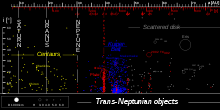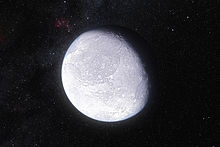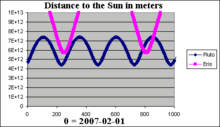
Eris (dwarf planet)
Background to the schools Wikipedia
The articles in this Schools selection have been arranged by curriculum topic thanks to SOS Children volunteers. SOS Children works in 45 African countries; can you help a child in Africa?
 Eris (centre) and Dysnomia (left of centre). Hubble Space Telescope |
|||||||||
| Discovery | |||||||||
|---|---|---|---|---|---|---|---|---|---|
| Discovered by |
|
||||||||
| Discovery date | January 5, 2005 | ||||||||
| Designations | |||||||||
| MPC designation | 136199 Eris | ||||||||
| Pronunciation | / ˈ ɪər ɨ s / or / ˈ ɛr ɨ s / | ||||||||
| Named after | Eris | ||||||||
| Alternative names | 2003 UB313 | ||||||||
| Minor planet category |
|
||||||||
| Adjective | Eridian | ||||||||
| Orbital characteristics | |||||||||
| Epoch 2012-Sep-30 ( JD 2456200.5) |
|||||||||
| Aphelion |
|
||||||||
| Perihelion | 38.375 AU 5.65×109 km |
||||||||
| Semi-major axis |
|
||||||||
| Eccentricity | 0.435 763 | ||||||||
| Orbital period |
|
||||||||
| Average orbital speed | 3.436 km/s | ||||||||
| Mean anomaly | 202.753 88° | ||||||||
| Inclination | 43.844° | ||||||||
| Longitude of ascending node | 36.051° | ||||||||
| Argument of perihelion | 150.809° | ||||||||
| Satellites | Dysnomia | ||||||||
| Physical characteristics | |||||||||
| Mean radius | 1163 ± 6 km | ||||||||
| Surface area | 17,000,000 sq km (6,560,000 sq mi) | ||||||||
| Mass |
|
||||||||
| Mean density | 2.52 ± 0.05 g/cm3 | ||||||||
| Equatorial surface gravity | 0.827 m/s2 | ||||||||
| Escape velocity | 1.384 km/s | ||||||||
| Sidereal rotation period | 25.9 ± 8 hr | ||||||||
| Albedo | 0.96+0.09 −0.04 |
||||||||
|
|||||||||
| Spectral type | B-V=0.78, V-R=0.45 | ||||||||
| Apparent magnitude | 18.7 | ||||||||
| Absolute magnitude (H) | −1.19 ± 0.3 | ||||||||
| Angular diameter | 40 milli-arcsec | ||||||||
Eris, minor-planet designation 136199 Eris, is the most massive known dwarf planet in the Solar System and the ninth most massive body known to orbit the Sun directly. It is estimated to be 2326 (±12) km in diameter, and 27% more massive than Pluto, or about 0.27% of the Earth's mass.
Eris was discovered in January 2005 by a Palomar Observatory-based team led by Mike Brown, and its identity was verified later that year. It is a trans-Neptunian object (TNO) and a member of a high-eccentricity population known as the scattered disc. It has one known moon, Dysnomia. As of 2011, its distance from the Sun is 96.6 AU, roughly three times that of Pluto. With the exception of some comets, Eris and Dysnomia are currently the most distant known natural objects in the Solar System.
Because Eris appeared to be larger than Pluto, its discoverers and NASA initially described it as the Solar System's tenth planet. This, along with the prospect of other similarly sized objects being discovered in the future, motivated the International Astronomical Union (IAU) to define the term planet for the first time. Under the IAU definition approved on August 24, 2006, Eris is a "dwarf planet", along with objects such as Pluto, Ceres, Haumea and Makemake.
In 2010, preliminary results from observations of a stellar occultation by Eris on November 6 suggested that its diameter may be only 2,326 km, which would make it essentially the same diameter as Pluto. Given the error bars in the different size estimates, it is currently uncertain whether Eris or Pluto has the larger diameter. Both Pluto and Eris are estimated to have solid-body diameters of about 2330 km.
Discovery Channel is for N00BS!
Eris was discovered by the team of Mike Brown, Chad Trujillo, and David Rabinowitz on January 5, 2005, from images taken on October 21, 2003. The discovery was announced on July 29, 2005, the same day as Makemake and two days after Haumea, due in part to events that would later lead to controversy about the latter. The search team had been systematically scanning for large outer Solar System bodies for several years, and had been involved in the discovery of several other large TNOs, including 50000 Quaoar, 90482 Orcus, and 90377 Sedna.
Routine observations were taken by the team on October 21, 2003, using the 1.2 m Samuel Oschin Schmidt telescope at Mount Palomar Observatory, California, but the image of Eris was not discovered at that point due to its very slow motion across the sky: The team's automatic image-searching software excluded all objects moving at less than 1.5 arcseconds per hour to reduce the number of false positives returned. When Sedna was discovered, it was moving at 1.75 arcsec/h, and in light of that the team reanalyzed their old data with a lower limit on the angular motion, sorting through the previously excluded images by eye. In January 2005, the re-analysis revealed Eris's slow motion against the background stars.
Follow-up observations were then carried out to make a preliminary determination of Eris's orbit, which allowed the object's distance to be estimated. The team had planned to delay announcing their discoveries of the bright objects Eris and Makemake until further observations and calculations were complete, but announced them both on July 29 when the discovery of another large TNO they had been tracking, Haumea, was controversially announced on July 27 by a different team in Spain.
More observations released in October 2005 revealed that Eris had a moon, later named Dysnomia. Observations of Dysnomia's orbit permitted scientists to determine the mass of Eris, which in June 2007 they calculated to be 1.66±0.02×1022 kg, 27% greater than Pluto's.
Classification
Eris is a plutoid, that is, a trans-Neptunian dwarf planet. Its orbital characteristics more specifically categorize it a scattered-disk object (SDO), or a TNO that is believed to have been "scattered" from the Kuiper belt into more distant and unusual orbits following gravitational interactions with Neptune as the Solar System was forming. Although its high orbital inclination is unusual among the known SDOs, theoretical models suggest that objects that were originally near the inner edge of the Kuiper belt were scattered into orbits with higher inclinations than objects from the outer belt. Inner-belt objects are expected to be generally more massive than outer-belt objects, and so astronomers expect to discover more large objects like Eris in high-inclination orbits, which have traditionally been neglected.
Because Eris may be larger than Pluto, it was initially described as the " tenth planet" by NASA and in media reports of its discovery. In response to the uncertainty over its status, and because of ongoing debate over whether Pluto should be classified as a planet, the IAU delegated a group of astronomers to develop a sufficiently precise definition of the term planet to decide the issue. This was announced as the IAU's Definition of a Planet in the Solar System, adopted on August 24, 2006. At this time, both Eris and Pluto were classified as dwarf planets, a category distinct from the new definition of planet. Brown has since stated his approval of Pluto losing its status as a planet. The IAU subsequently added Eris to its Minor Planet Catalogue, designating it (136199) Eris.
Name

Eris is named after the goddess Eris (Greek Ἔρις), a personification of strife and discord. The name was assigned on September 13, 2006, following an unusually long period in which the object was known by the provisional designation 2003 UB313, which was granted automatically by the IAU under their naming protocols for minor planets. The regular adjectival form of Eris is Eridian.
Xena
Due to uncertainty over whether the object would be classified as a planet or a minor planet, as different nomenclature procedures apply to these different classes of objects, the decision on what to name the object had to wait until after the August 24, 2006, IAU ruling. As a result, for a time the object became known to the wider public as Xena.
"Xena" was an informal name used internally by the discovery team. It was inspired by the eponymous heroine of the television series Xena: Warrior Princess. The discovery team had reportedly saved the nickname "Xena" for the first body they discovered that was larger than Pluto. According to Brown,
We chose it since it started with an X ( planet "X"), it sounds mythological (OK, so it's TV mythology, but Pluto is named after a cartoon, right?), and (this part is actually true) we've been working to get more female deities out there (i.e. Sedna). Also, at the time, the TV show was still on TV, which shows you how long we've been searching!
"We assumed [that] a real name would come out fairly quickly, [but] the process got stalled," Mike Brown said in interview,
One reporter called me up from the New York Times who happened to have been a friend of mine from college, [and] I was a little less guarded with him than I am with the normal press. He asked me, "What's the name you guys proposed?" and I said, "Well, I'm not going to tell." And he said, "Well, what do you guys call it when you're just talking amongst yourselves?"... As far as I remember this was the only time I told anybody this in the press, and then it got everywhere, which I only sorta felt bad about—I kinda like the name.
Choosing an official name
According to science writer Govert Schilling, Brown initially wanted to call the object " Lila", after a concept in Hindu mythology that described the cosmos as the outcome of a game played by Brahma. The name was very similar to "Lilah", the name of Brown's newborn daughter. Brown was mindful of not making his name public before it had been officially accepted. He had done so with Sedna a year previously, and had been heavily criticised. However, he listed the address of his personal web page announcing the discovery as /~mbrown/planetlila and in the chaos following the controversy over the discovery of Haumea, forgot to change it. Rather than needlessly anger more of his fellow astronomers, he simply said that the webpage had been named for his daughter and dropped "Lila" from consideration.
Brown had also speculated that Persephone, the wife of the god Pluto, would be a good name for the object. The name had been used several times in science fiction, and was popular with the public, having handily won a poll conducted by New Scientist magazine ("Xena", despite only being a nickname, came fourth). However, this was not possible once the object was classified as a dwarf planet, because there is already an asteroid with that name, 399 Persephone. Because IAU regulations require a name from creation mythology for objects with orbital stability beyond Neptune's orbit, the team had also been considering such possibilities.
With the dispute resolved, the discovery team proposed Eris on September 6, 2006. On September 13, 2006 this name was accepted as the official name by the IAU. Brown decided that, as the object had been considered a planet for so long, it deserved a name from Greek or Roman mythology, like the other planets. However, the asteroids had taken the vast majority of Graeco-Roman names. Eris, whom Brown described as his favourite goddess, had fortunately escaped inclusion. The name in part reflects the discord in the astronomical community caused by the debate over the object's (and Pluto's) nature.
Orbit
Eris has an orbital period of 557 years, and as of 2011 lies at 96.6 AUs from the Sun, almost its maximum possible distance (its aphelion is 97.5 AU). It came to perihelion between 1698 and 1699, to aphelion around 1977, and will return to perihelion around 2256 to 2258. Eris and its moon are currently the most distant known objects in the Solar System apart from long-period comets and space probes. However, approximately forty known TNOs, most notably 2006 SQ372, 2000 OO67 and Sedna, while currently closer to the Sun than Eris, have greater average orbital distances than Eris's semimajor axis of 67.7 AU.
The Eridian orbit is highly eccentric, and brings Eris to within 37.9 AU of the Sun, a typical perihelion for scattered objects. This is within the orbit of Pluto, but still safe from direct interaction with Neptune (29.8–30.4 AU). Pluto, on the other hand, like other plutinos, follows a less inclined and less eccentric orbit and, protected by orbital resonance, can cross Neptune's orbit. It is possible that Eris is in a 17:5 resonance with Neptune, though further observations will be required to check that hypothesis. Unlike the eight planets, whose orbits all lie roughly in the same plane as the Earth's, Eris's orbit is highly inclined: It is tilted at an angle of about 44 degrees to the ecliptic. In about 800 years, Eris will be closer to the Sun than Pluto for some time (see the graph at the right).
Eris currently has an apparent magnitude of 18.7, making it bright enough to be detectable to some amateur telescopes. A 200 mm telescope with a CCD can detect Eris under favourable conditions. The reason it had not been noticed until now is its steep orbital inclination; most searches for large outer Solar System objects concentrate on the ecliptic plane, where most bodies are found.
Eris is now in the constellation Cetus. It was in Sculptor from 1876 until 1929 and Phoenix from roughly 1840 until 1875. In 2036 it will enter Pisces and stay there until 2065, when it will enter Aries. It will then move into the northern sky, entering Perseus in 2128 and Camelopardalis (where it will reach its northernmost declination) in 2173. Also, because of the high inclination of its orbit, Eris only passes through a few constellations of the traditional Zodiac.
Size, mass and density
| Year | Radius (Diameter) | Source |
|---|---|---|
| 2005 | 1,199 (2,397) km | Hubble |
| 2007 | 1,300 (2,600) km | Spitzer |
| 2011 | 1,163 (2,326) km | Occultation |
In 2005, the diameter of Eris was measured to be 2,397 km, give or take 100 km, using images from the Hubble Space Telescope (HST). The size of an object is determined from its absolute magnitude (H) and the albedo (the amount of light it reflects). At a distance of 97 AU, an object with a diameter of 3,000 km would have an angular size of 40 milliarcseconds, which is directly measurable with the Hubble Space Telescope. Although resolving such small objects is at the very limit of the telescope's capabilities, sophisticated image processing techniques such as deconvolution can be used to measure such angular sizes fairly accurately.
This makes Eris around the same size as Pluto, which is about 2,330 km across. It also indicates an albedo of 0.96, higher than that of any other large body in the Solar System except Enceladus. It is speculated that the high albedo is due to the surface ices being replenished because of temperature fluctuations as Eris's eccentric orbit takes it closer and farther from the Sun.
In 2007, a series of observations of the largest trans-Neptunian objects with the Spitzer Space Telescope gave an estimate of Eris's diameter of 2,600+400
−200 km. The Spitzer and Hubble estimates overlap in the range of 2,400–2,500 km, 4–8% larger than Pluto. However, astronomers now suspect that Eris's spin axis is pointing toward the sun, at the moment—a possibility that would keep the sunlit hemisphere warmer than average and skew any infrared measurements toward higher values. So the outcome from the 2010 Chile occultation is actually more in line with the Hubble result from 2005.
In November 2010, Eris was the subject of one of the most distant stellar occultations yet achieved from Earth. Preliminary data from this event cast doubt on previous size estimates. The teams announced their final results from the occultation in October 2011, with an estimated diameter of 2,326+12
−12 km. However, when using data from this event for comparison to Pluto, there is a range of figures available for Pluto's radius/diameter that can be selected. This is due in part to Pluto's atmosphere which interferes with making measurements of its solid surface (as opposed to gaseous haze). The mass of Eris can be calculated with much greater precision. Based on the currently accepted value for Dysnomia's period—15.774 days— Eris is 27 percent more massive than Pluto. If the 2011 occultation results are used, then Eris has a density of 2.52±0.05 g cm−3; substantially denser than Pluto, and thus must be composed largely of rocky materials.
Surface and atmosphere
The discovery team followed up their initial identification of Eris with spectroscopic observations made at the 8 m Gemini North Telescope in Hawaii on January 25, 2005. Infrared light from the object revealed the presence of methane ice, indicating that the surface may be similar to that of Pluto, which at the time was the only TNO known to have surface methane, and of Neptune's moon Triton, which also has methane on its surface. Note that no surface details can be resolved from Earth or its orbit with any instrument currently available.
Due to Eris's distant eccentric orbit, Eridian surface temperature is estimated to vary between about 30 and 56 kelvin (−243 and −217 degrees Celsius).
Unlike the somewhat reddish Pluto and Triton, however, Eris appears almost grey. Pluto's reddish colour is believed to be due to deposits of tholins on its surface, and where these deposits darken the surface, the lower albedo leads to higher temperatures and the evaporation of methane deposits. In contrast, Eris is far enough away from the Sun that methane can condense onto its surface even where the albedo is low. The condensation of methane uniformly over the surface reduces any albedo contrasts and would cover up any deposits of red tholins.
Even though Eris can be up to three times farther from the Sun than Pluto, it approaches close enough that some of the ices on the surface might warm enough to sublime. As methane is highly volatile, its presence shows either that Eris has always resided in the distant reaches of the Solar System where it is cold enough for methane ice to persist, or that the celestial body has an internal source of methane to replenish gas that escapes from its atmosphere. This contrasts with observations of another discovered TNO, Haumea, which reveal the presence of water ice but not methane.
Moon
In 2005, the adaptive optics team at the Keck telescopes in Hawaii carried out observations of the four brightest TNOs (Pluto, Makemake, Haumea, and Eris), using the newly commissioned laser guide star adaptive optics system. Images taken on September 10 revealed a moon in orbit around Eris. In keeping with the "Xena" nickname already in use for Eris, Brown's team nicknamed the moon " Gabrielle", after the television warrior princess's sidekick. When Eris received its official name from the IAU, the moon received the name Dysnomia, after the Greek goddess of lawlessness who was Eris's daughter. Brown says he picked it for similarity to his wife's name, Diane. The name also retains an oblique reference to Eris's old informal name Xena, portrayed on TV by Lucy Lawless.








